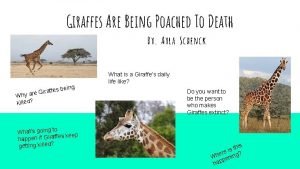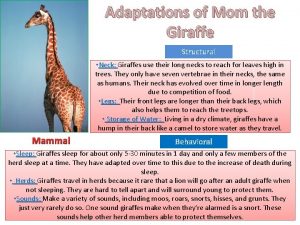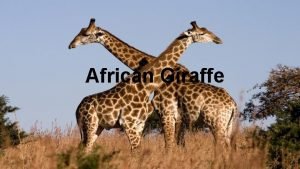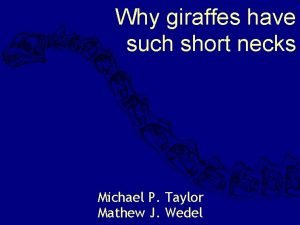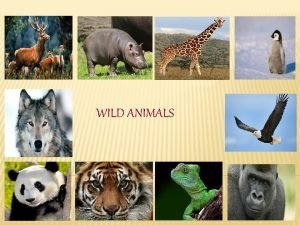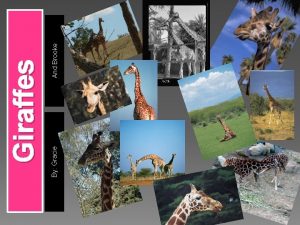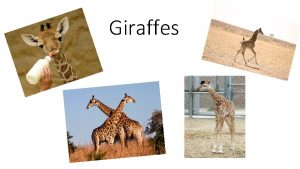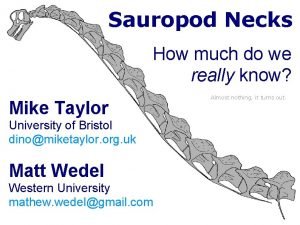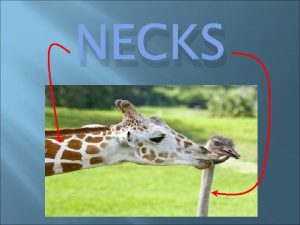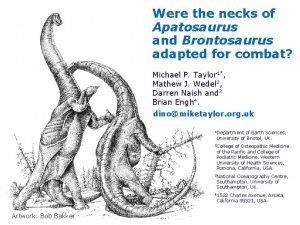How do giraffes get long necks Evolution Learning













- Slides: 13

How do giraffes get long necks?


Evolution Learning Objective: In order to be successful in this lesson you must be able to: Describe and explain the effects of competition on different populations of organisms Success…

Learning Objective: Interpret information Explain why Darwin’s Describe Darwin’s theory from evolutionary trees theory was only of evolution by natural to explain how closely gradually accepted selection and compare related species are. In order to be successful in this lesson you must be able to: with Lamarck’s theory. Success…

Theories of evolution Read through sheet explaining Darwin and Lamarck’s theories of evolution. Explain each to your learning partner Tell me.

Natural Selection Darwins theory is often referred to as Darwin’s theory of evolution by natural selection Explain how natural selection occurs. 3 marks variation (between organisms within species) allow described example allow mutation – but not if caused by change in conditions 1 those most suited / fittest survive 1 genes / alleles passed on (to offspring / next generation) allow mutation passed on 1

Gradual acceptance. . . Darwins theory was only gradually accepted because. . . 1. The theory challenged that God made all the animals and plants on earth 2. There was insufficient evidence at the time to convince most scientists 3. The mechanism of variation and inheritance was not understood until 50 years after Darwin’s theory was published.

Apply your knowledge The image below shows: • Phiomia, an ancestor of elephants • a modern African elephant. Phiomia lived about 35 million years ago. Phiomia African elephant Both Phiomia and the African elephant reach up into trees to get leaves. In the 1800 s, Darwin and Lamarck had different theories about how the long nose of Phiomia evolved into the trunk of the African elephant. (i) Use Darwin’s theory of natural selection to explain how the elephant’s trunk evolved. (4 marks) (ii) Lamarck’s theory is different from Darwin’s theory. Use Lamarck’s theory to explain how the elephant’s trunk evolved. (2 marks) (i) In the 1800 s, many scientists could not decide whether Lamarck’s theory or Darwin’s theory was the right one. Give two reasons why. (2) (ii) Before the 1800 s, many people had a different idea to explain where all the living things on Earth came from. What idea was this? (1)

(i) variation (in population) / mutation 1 longer nosed individuals get more food / leaves allow longer nosed individuals more likely to survive 1 (these) survivors breed (more) 1 pass on genes / alleles / DNA (for long nose) allow pass on mutation 1 ii) Phiomia / ancestor stretched its nose (during its lifetime) to reach food / leaves 1 ( passed on (stretched nose) to offspring allow offspring inherit (stretched nose) do not allow ref to genes 1 (i) insufficient evidence / no proof ignore other theories, eg religion do not allow no evidence 1 mechanism of inheritance not known allow genes / DNA not discovered 1 (ii) God made all living things / them allow creationism ignore religion 1

Evolutionary trees In this evolutionary tree, species A and B share a common ancestor. Species F and G share a common ancestor, which itself shared a common ancestor with species E. All seven species share a common ancestor, probably from the distant past. The more closely related the species, the closer the branches are


Evolutionary trees

M 1. (a) lemur(s) 1 (b) gorilla(s) in either order 1 chimpanzee(s) accept chimps 1 (c) (i) vegetarian finch 1 (ii) R 1 (iii) mangrove and woodpecker finches 1 (d) (i) tree 1 (ii) hippopotamus and pig both required, either order allow hippo 1 (iii) new evidence from fossils 1
 How are giraffes long necks adapted to their lifestyle
How are giraffes long necks adapted to their lifestyle Get on get off
Get on get off Refrain poetic device
Refrain poetic device Tall+short h
Tall+short h Once upon a time there lived a little girl
Once upon a time there lived a little girl Why are giraffes poached
Why are giraffes poached Structural adaptations of giraffes
Structural adaptations of giraffes Vestigial structures in giraffes
Vestigial structures in giraffes Where do giraffes live
Where do giraffes live Giraffes like acacia leaves and hay
Giraffes like acacia leaves and hay What is paraphrasing
What is paraphrasing Giraffes like acacia leaves and hay
Giraffes like acacia leaves and hay Giraffes natural selection
Giraffes natural selection Get up get moving quiz
Get up get moving quiz





